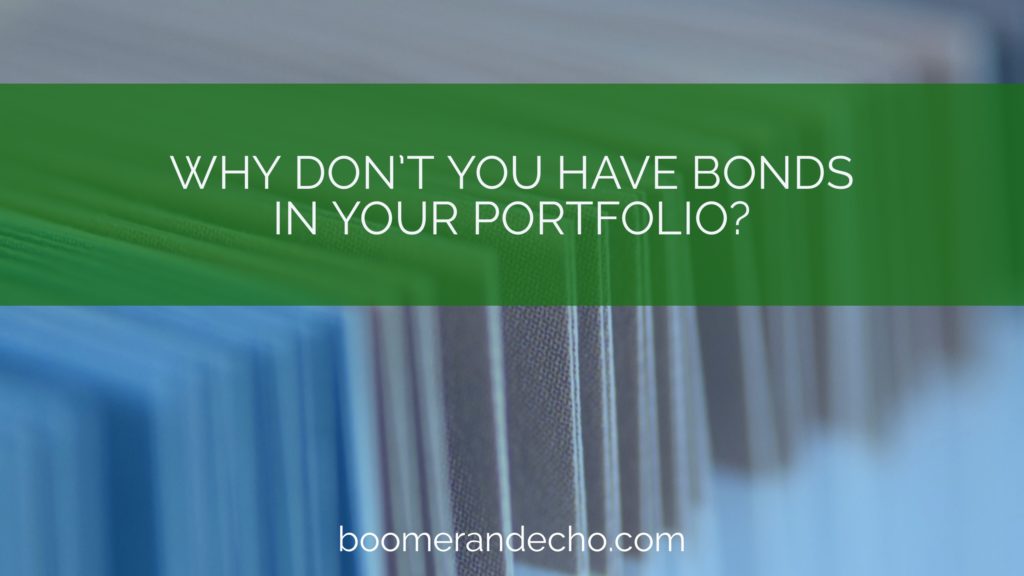Confession time: I’ve never held bonds in my portfolio. I didn’t own bonds when my portfolio was filled with Canadian dividend stocks, and there’s no bonds in it today. Instead I’ve opted for a two-ETF all-equity portfolio. I don’t have anything against bonds, in fact if you were to ask me to build you a diversified investment portfolio I’d definitely recommend a balanced solution that includes bonds.
Balanced portfolios are widely recommended, and for good reason. A typical investment portfolio consisting of 60 percent stocks and 40 percent bonds has served investors well for many decades.
Take the three-ETF model portfolio recommended on the Canadian Couch Potato website, for example. Over a 20-year period ending December 31, 2016, the balanced portfolio option made up of 40 percent bonds, 20 percent Canadian equities, and 40 percent international equities, returned 6.56 percent a year. That compares favourably with the aggressive portfolio consisting of 90 percent equities and just 10 percent bonds, which returned 6.63 percent a year.
Bonds smooth out investment returns and make it easier for investors to stomach the stock market when it decides to go into rollercoaster mode. Over the same 20-year period described above, the balanced portfolio’s lowest 12-month return (during the great financial crisis) was -19.28 percent. The aggressive portfolio, on the other hand, dropped 30.57 percent during the same period. That’s a lot of volatility to stomach for a measly 0.07 percent annual gain.
Bonds can also help you rebalance your portfolio. When the stock market is slumping, simply sell some of your bond holdings to buy stocks while they’re on sale. Conversely, when stocks are overheated you can trim back some of your holdings and add to your bond portion to bring your portfolio back into balance.
So for those reasons a balanced portfolio will likely continue to serve investors well and post solid if unspectacular returns over the long term.
All that said, I still plan to hold all stocks and no bonds in my portfolio – and here’s why:

Why no bonds in your portfolio?
Before deciding on the makeup of my investment portfolio I took a broad look at my finances and found a lot of bond-like components. Remember, a bond is something that delivers a steady, predictable income stream.
First of all, I receive a steady monthly paycheque from my public-sector employer. I run a successful side-business that also generates monthly income, some of which is of the passive variety. My job comes with a defined benefit pension plan, which guarantees another steady income stream in retirement and reduces the need for draw from my investments post-employment. That pension, combined with CPP and OAS, should cover my basic needs in retirement and act as the fixed income portion of my retirement income.
Then there’s my age to consider. At 38, I’m no spring chicken but I’m still decades away from full-stop retirement. While it’s likely we’ll see another stock market crash of 20 percent or more in the next two decades, there’s still plenty of time for the markets to recover (and they always do).
An all-equity portfolio, while certainly riskier in the short-term, is a near lock to outperform other asset classes over the very long term. In Jeremy Siegel’s classic, Stocks for the Long Run, the author looks at 200 years of historical data and determined that stocks have returned an average of 6.5 percent to 7 percent per year after inflation. Bonds, meanwhile, returned less than 2 percent a year after inflation.
Couple that with the fact that bonds have been in a bull market since 1980 as plunging interest rates sent bond prices soaring. We’re unlikely to see that type of environment over the next 20 to 30 years as interest rates start to tick back up and (dare I say) normalize. Seigel expects lower returns from both stocks and bonds in the future:
“Stock returns are likely to be somewhat lower in the future. I now look for about 5% to 5.5% as the long-run equity return after inflation. On bonds, after inflation returns are very likely zero or perhaps even negative.”
Finally, I know myself as an investor and I truly believe with my four-minute portfolio I have the tools and the temperament to handle a major market crash without panicking.
Final thoughts
Why no bonds in my portfolio? Because I’m a relatively young investor with a steady public sector job, a successful side-business, and a defined benefit pension plan waiting for me in retirement. I believe in stocks for the long run, meaning stocks will outperform other asset classes, like bonds, over the very long term (as long as I can handle the short term volatility). This equity premium should be more pronounced in the future as bonds are coming off an incredible 30-year run.
But that’s me (and my unique situation). Not everyone can handle an all-equity portfolio and therefore most investors should hold bonds in some type of balanced portfolio.